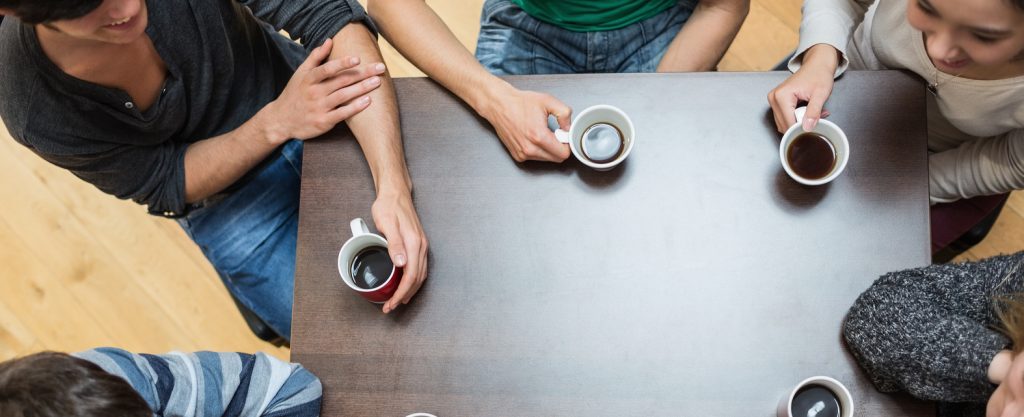
How can we gain more from group interactions? We’re happy to repost a reflection to help answer this question written by Victoria Fann and originally posted here.
Also, check out another one of her reposts where she discusses her Ben Franklin Circle here.
Here is Victoria’s Post:
As Ben Franklin discovered hundreds of years ago, something magical happens when a group of people get together to engage in meaningful conversation: that circle of individuals becomes something far greater than the sum of its parts. A powerful, dynamic energy emerges from the group collective and creates access to all the combined energy, tools, inspiration, the information, wisdom, insights and resources of that group of people.
In this context, people are able to share great levels of wisdom, become vulnerable with each other, establish a higher level of trust than they would in a social setting and have a deep level of intimacy with people they barely even know very quickly.
In addition, small groups that connect deeply often facilitate high levels of motivation, honesty, healing, growth, learning that can motivate people to take think and behave in ways that they might not have considered before. When someone tells a story or models something new, it opens up a whole new range of possibilities, which ultimately, can foster hope and optimism.
Given what’s happening in our world today, with loneliness becoming an epidemic and suicide rates rising, this is extraordinary. And yet it’s something that isn’t done enough.
Yes, there are thousands of Meetup groups happening around the world based on common interests. But, unless there are certain conditions, those meetings will not yield the same transformative power as a small group having a deep discussion in a quiet environment.
So what are the conditions that opens the doors to the extraordinary?
It’s fairly simple really. The right setting, a good set of guidelines and gentle facilitation.
Setting
Let’s talk about the setting first. I’ve run successful groups for close to thirty years, and the majority of those groups took place in my living room or the living room of a group member. Why? Because it’s one of the few places that combines privacy, comfort, quiet, natural lighting, a friendly host, non-public bathroom, occasional adorable pets, etc. If you want a group of people to relax, take off their masks, open up and share their stories, gather them in an environment that is familiar, that is associated with relaxation and ease and feels more like a gathering of friends than a business meeting. No other setting even comes close to this.
Our Ben Franklin Circle initially met in a local café, and while it was nice to be able to buy coffee and baked goods, it ended up being too noisy and not private enough. Plus, we were sitting around tables in wooden chairs with a table between us. Shifting to a living room setting in a member’s home sitting on comfortable chairs and couches, created a totally different experience that immediately allowed us to deepen the discussion. You could almost hear the collective sigh of relief.
But setting alone isn’t enough. In fact, when you’re in a less formal setting, the tendency would be to fall back into casual, undirected discussion. This is why there is a strong need for guidelines.
Guidelines
Again, these are simple and not at all inhibiting. Instead, they create an even deeper level of trust and relaxation because the participants know that they will be heard and that conversation will stay on topic, and not degenerate into debates and philosophizing.
Here is the guideline that I created years ago for all the groups I’ve run and am currently using in our Circle:
Speak from the heart and from direct experience using “I” statements.
Speak without interruption or cross-talk.
Respect each other’s need for silence as well as each other’s need to speak and be heard.
Listen from the heart and serve as a compassionate witness for other people in the circle. To be an effective witness means paying attention to what’s being said without interpreting, judging, or trying to “fix” or rescue the person speaking.
Respect each other’s privacy and keep everything that’s shared confidential.
These guidelines are not new nor are they unique. However, they are incredibly effective creating a group experience that is deeply rewarding.
Gentle Facilitation
Finally, it is important to have someone that is able to lead the group with a gentle hand. Mostly, this person presents conversation-starting questions and quotes (or as I mentioned in a previous blog post allows them to be drawn from a hat), keeps the conversation on topic, makes sure everyone has had an equal opportunity to share and be heard and generally tunes into what is needed by the group. That sounds like it’s a lot, but it’s fairly simple. A good facilitator is one that fades into the background and appears to participate in the same way as other members. This establishes trust and removes any sense of hierarchy.
In my experience, setting, guidelines and gentle facilitation are what makes a good group experience, an extraordinary one.
I will leave you with a little food for thought from Ben Franklin:
“To expect people to be good, to be just, to be temperate, etc., without showing them how they should become so, seems like the ineffectual charity mentioned by the apostle, which consisted in saying to the hungry, the cold and the naked, be ye fed, be ye warmed, be ye clothed, without showing them how they should get food, fire or clothing.”
Victoria Fann is a writer, transformational coach, group facilitator and workshop leader. Her Ben Franklin Circle meets in Weaverville, NC.